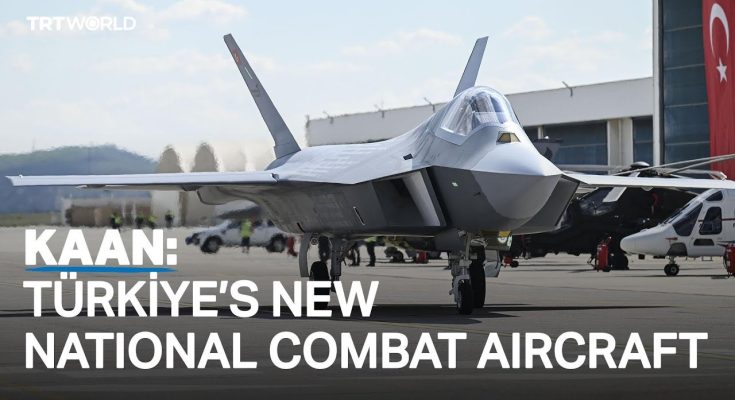KAAN: Türkiye’s New National Combat Aircraft
In a significant leap forward for its defense industry, Turkey has unveiled its new indigenous stealth fighter jet, the KAAN, marking a monumental milestone in the country’s military aviation program. The KAAN, named after the title used for Turkic rulers, symbolizes Turkey’s ambition to develop cutting-edge technologies and reduce its reliance on foreign defense systems. As an advanced fifth-generation fighter, the KAAN is poised to elevate Turkey’s air combat capabilities while bolstering its position in regional and global military power dynamics.
A Vision of National Defense Autonomy
Turkey’s defense industry has made significant strides over the past few decades, and the development of the KAAN reflects the nation’s strategic aim to achieve self-sufficiency in defense technologies. Historically, Turkey has relied on foreign-made aircraft, including the American-made F-16 and F-4 Phantom jets. However, with the rise of geopolitical tensions in the region, particularly after the suspension of Turkey’s participation in the F-35 program, Turkey accelerated efforts to develop its own advanced fighter jet. The KAAN project, led by Turkish Aerospace Industries (TAI), represents the culmination of years of research and development into stealth technology, avionics, and aerospace engineering.
Key Features of the KAAN
- Stealth and Aerodynamics:
One of the standout features of the KAAN is its stealth design. The aircraft has been optimized to reduce its radar cross-section, making it difficult for enemy radar systems to detect. The sleek and angular body design, combined with advanced composite materials, ensures the aircraft remains highly maneuverable while minimizing its visibility in contested airspace. This makes the KAAN capable of operating in hostile environments where air defenses are sophisticated and heavily contested. - Advanced Avionics and Systems:
The KAAN is equipped with state-of-the-art avionics, including next-generation radar, electronic warfare capabilities, and sensor fusion. This allows the pilot to access a wealth of real-time data, significantly enhancing situational awareness. The jet can detect and track multiple targets, providing an edge in both offensive and defensive operations. The aircraft also features an integrated weapons system, capable of carrying a wide array of air-to-air and air-to-ground munitions, giving it the versatility needed to fulfill multirole missions, from air superiority to precision strikes. - AI and Autonomy:
Another forward-looking aspect of the KAAN is its integration with artificial intelligence (AI) systems. AI is expected to play a crucial role in the aircraft’s operations, assisting in mission planning, flight management, and even tactical decision-making. The KAAN is also designed to work seamlessly with unmanned aerial systems (UAS), expanding its operational scope and flexibility. - Multirole Capabilities:
The KAAN is a multirole fighter, designed to perform a range of missions, including air-to-air combat, close air support, and ground strike operations. It is capable of carrying an assortment of smart bombs, missiles, and other ordnance, making it adaptable to various mission requirements. The fighter is also designed for interoperability with NATO systems, allowing Turkey to integrate it into joint operations with allied forces if necessary.
Strategic Importance for Turkey
The development of the KAAN represents a major step toward Turkey’s goal of becoming a leading player in the global defense industry. The aircraft not only enhances Turkey’s national defense capabilities but also reduces its dependence on foreign suppliers. This is especially important in light of Turkey’s experience with the United States’ decision to remove it from the F-35 program due to political tensions. By creating its own advanced fighter jet, Turkey has ensured that it will not be reliant on foreign countries for the future of its air force.
Furthermore, the KAAN strengthens Turkey’s strategic position within NATO and its influence in the Middle East. The aircraft’s capabilities, coupled with Turkey’s growing military alliances, will allow the country to play a more prominent role in regional security dynamics. The KAAN also serves as a symbol of national pride, reflecting Turkey’s aspirations to become an independent and self-sufficient military power.
Challenges Ahead
Despite the excitement surrounding the KAAN, there are still challenges ahead. The aircraft is in the developmental phase, and while it has made significant progress, testing and full production will take time. Additionally, Turkey will need to ensure the aircraft’s compatibility with existing air force infrastructure, including logistics, maintenance, and pilot training. The complexity of manufacturing cutting-edge defense technologies also requires overcoming various engineering hurdles, but with the success of projects like the Anka UAV and Bayraktar TB2, Turkey has proven its capabilities in overcoming such obstacles.
Conclusion
The KAAN represents a bold leap for Turkey into the world of advanced fighter aircraft. It is not just a piece of military hardware but a testament to Turkey’s commitment to strengthening its defense autonomy and technological capabilities. As the KAAN progresses toward full operational status, it will likely become a cornerstone of Turkey’s air power, enhancing its strategic capabilities both regionally and globally. By developing an indigenous fighter jet, Turkey is solidifying its place as a rising power in military aviation, signaling a new era of self-reliance and innovation in defense technology.



